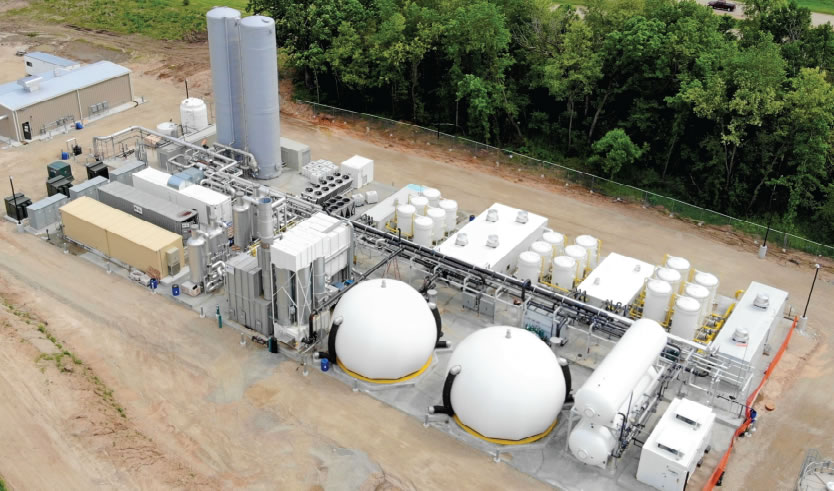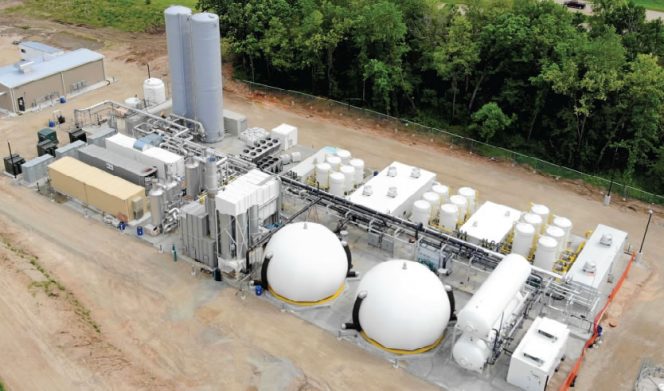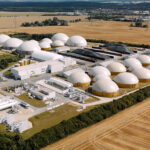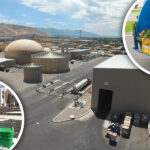BioCycle August 2019
Sacramento, California: RNG Market Surpasses 100 Projects In North America
The Coalition for Renewable Natural Gas (RNG Coalition) announced that the North American RNG industry has reached the 100-facility benchmark this summer. With the addition of three recent operational facilities, the 101 RNG production sites across the continent equate to nearly 150 percent growth over the past five years from the 41 projects built between 1982 and 2014. The RNG Coalition was founded 8 years ago when there were 31 operating RNG projects in North America. Having reached 50 RNG sites in 2015, the organization set the goal to double the number of production facilities in North America within 10 years. The RNG industry hit that target in half that time, notes Johannes Escudero, RNG Coalition co-founder and CEO.
Three DTE Biomass Energy facilities in Wisconsin that convert cow manure from area dairies into renewable energy are among the new RNG production sites this year. Mark Hill, Vice President, Dairy Operations, at DTE Biomass Energy will be giving an update on these projects at BioCycle REFOR19 in October . According to the RNG Coalition’s database of RNG production sites, there are more than 50 additional facilities currently under construction or in development.>
Salem, Oregon: Governor Signs RNG Law
Oregon Governor Kate Brown signed Senate Bill 98 into law at the end of July, creating the path for renewable natural gas (RNG) to become an increasing part of the state’s energy supply. SB 98 outlines voluntary goals for Oregon’s natural gas utilities to add as much as 30 percent renewable natural gas (RNG) into the state’s pipeline system. There will be limits on the total amount paid for RNG that is overseen by regulators, protecting utilities and ratepayers from excessive costs as the market develops. “Allowing our natural gas utilities to acquire a renewable product for their customers brings us one step closer to a clean energy future,” said Brown.
The new law allows utility investment in the interconnection of RNG production and supports targets of 15 percent by 2030, 20 percent by 2035 and 30 percent by 2050. It also provides local communities a potential revenue source to turn their waste into energy.
“Several states have advanced policies in recent years to support RNG, however, the Oregon law goes further than any other by setting clear goals for renewable natural gas procurement,” explains Nina Kapoor, director of State Government Affairs for the Coalition for Renewable Natural Gas. Natural gas utilities in the state are regulated by the Public Utility Commission of Oregon; under current rules they have an obligation to deliver the least-cost commodity to customers. This has been a barrier to purchasing and distributing RNG to Oregon customers, which can cost more in the same way that renewable electricity can cost more. Senate Bill 98 will support all forms of RNG including renewable hydrogen.
NW Natural, a subsidiary of NW Natural Holding Company, based in Portland, Oregon, “plans to begin accepting homegrown renewable natural gas onto our pipeline system through several projects by 2020,” said NW Natural’s, president and CEO, David H. Anderson. The utility is working with the Metropolitan Wastewater Management Commission, a partnership of the cities of Eugene and Springfield and Lane County, to bring RNG onto the system, generated from methane produced during the wastewater treatment process. It’s also working with the City of Portland Bureau of Environmental Services, operator of the City of Portland’s Columbia Boulevard Wastewater Treatment Plant. Some of the RNG generated at the Columbia Boulevard facility will be used as fuel for City vehicles, while the remainder will be injected onto NW Natural’s system, noted Anderson.
Washington, D.C.: Proposed House Bill Benefits Biogas, Nutrient Recovery
The Agricultural Environmental Stewardship Act (H.R. 3744), introduced in mid-July by Congressmen Ron Kind (D-WI) and Tom Reed (R-NY), provides a 30 percent investment tax credit (ITC) for qualifying biogas and nutrient recovery systems. Currently, there are no tax incentives to encourage biogas or nutrient recovery. “The Agricultural Environmental Stewardship Act is a boost to on-farm economies and watershed protection everywhere,” notes Patrick Serfass, Executive Director of the American Biogas Council (ABC). “This bill incentivizes private investment in digester and nutrient recovery technologies which will create new jobs and protect air, water and soil.” A previous production tax credit under Section 45 of the federal tax code — which promoted use of renewable electricity — expired at the end of 2017. This new credit would promote the production of pipeline quality natural gas and compressed renewable natural gas vehicle fuel as well as nutrients that are essential to agricultural production, adds Serfass.
Los Angeles, California: Renewable Energy From Waste Resources
The United States could produce enough energy each year by harnessing waste — from landfill refuse to cow manure — to power the states of Oregon and Washington, while at the same time displacing 103 to 178 million metric tons of carbon dioxide emissions. These estimates are based on a new report — published in Nature Energy — by University of California, Los Angeles (UCLA) industrial ecologist and energy economist Deepak Rajagopal and urban planning doctoral candidate Bo Liu. The types of waste examined fit under the umbrella of bioenergy — renewable resources that are obtained from converting plant and animal material into electricity, biofuels or heat. Biofuel is one type of bioenergy that is widely produced in the U.S. — almost all of it coming from agricultural crops. Policymakers and business interests have promoted biofuels from crops, such as ethanol, for decades, however these come with negative environmental impacts. “The U.S. has tried biofuels, and they are important because we need more renewables, but we need better biofuels,” notes Rajagopal.
Using waste as a source instead could prove a sustainable alternative for future industry growth, say the authors, although benefits vary depending on what kind of waste is used, how it gets processed, what the end products are and where they’re produced. Rajagopal and Liu examined this variability by conducting life cycle analyses, or examinations of products from creation to end of life, of four types of waste: agricultural, forestry, landfill and cow manure. The study encompassed 15 energy conversion technologies and 29 waste types. In their analysis, the researchers combined existing data from the literature on waste conversion technologies with local waste availability from base-year estimates and electricity portfolios to determine relative energy gains and emissions reductions.
Overall, their study found that the U.S. has the potential to generate 3.1 to 3.8 exajoules (a measure of energy) of renewable energy each year using available waste resources. By comparison, the entire states of Washington and Oregon consumed about 3.3 exajoules of energy in 2017, according to the Energy Information Agency. The study also concluded that using waste products has the potential to displace 103 to 178 million metric tons of carbon dioxide emissions.
A key finding was that no one method of bioenergy production maximizes net energy gain, renewable energy gain and climate benefits. Some create more renewable energy, but require more energy to do so, resulting in less overall greenhouse gas emissions savings. Thus, identifying the optimal bioenergy application in any situation depends on the intended outcome.
Takoma Park, Maryland: U.S. Renewable Generating Capacity Surpasses Coal
According to an analysis of data recently released by the Federal Energy Regulatory Commission (FERC) by the SUN DAY Campaign, based in Takoma Park, , U.S. electrical generating capacity by renewable energy sources (i.e., biomass, geothermal, hydropower, solar, wind) has now — for the first time — surpassed that of coal. FERC’s “Energy Infrastructure Update” report (with data through April 30, 2019) notes that 18 “units” of new wind capacity (1,545 MW) and 102 units of new solar capacity (1,473 MW) were added during the first four months of 2019. Coupled with four units of new hydropower (29 MW), that was enough to push renewable energy’s share of total available installed U.S. generating capacity up to 21.56 percent. By comparison, coal’s share dropped to 21.55 percent (down from 23.04% a year ago).
FERC’s data also reveal that the nation’s renewable energy capacity has been adding, on average, a percentage point each year. A year ago, it was 20.66 percent; three years ago, it was 18.16 percent. Moreover, the same report indicates that by May 2022, proposed “high probability” generation additions and retirements could result in a net increase in renewable energy capacity of 40,993 MW. By comparison, net capacity by nuclear, coal, oil, and natural gas combined could actually decline by 24 MW, i.e., retirements would exceed additions.
Pixley, California: Supersize Dairy Biogas Facility To Supply RNG To Gas Utility
The Calgren Dairy Fuel renewable natural gas (RNG) facility in Pixley is described by project partners as the largest dairy biogas operation in the U.S., processing manure from local dairy farms in an anaerobic digestion system and producing pipeline quality RNG to be injected into the Southern California Gas Co. (SoCalGas) pipeline system. This enables Calgren to supply RNG to existing compressed natural gas (CNG) refueling facilities. The company currently partners with four dairy farms, and expects to service eight more by the end of 2019 (a total of more than 75,000 cows), “which will make the facility the largest dairy biogas project in the nation,” states a SoCalGas press release. “As part of our vision to be the cleanest natural gas company in North America, we have committed to replacing 20 percent of the natural gas we deliver today with RNG, primarily from organic sources, by 2030,” said Jeff Walker, vice president of customer solutions at SoCalGas. “Renewable natural gas is a ready, reliable and realistic way to reduce GHG emissions and pollution from heavy duty transportation and buildings and will help ensure that families and businesses have an affordable option for heating and cooking as California transitions to a clean energy future.” According to Walt Dwelle, principal owner of Calgren Renewable Fuels, this is “the first facility in California to operate a dairy digester pipeline cluster and to work with both the dairies and SoCalGas to mitigate emissions.”
To kickstart its RNG plan, SoCalGas will pursue regulatory authority to implement a broad RNG procurement program with a goal of replacing five percent of its natural gas supply with RNG by 2022. SoCalGas also recently filed a request with the California Public Utilities Commission (CPUC) to allow customers to purchase RNG for their homes. The utility seeks to have CPUC approval of its voluntary program by the end of the year.














